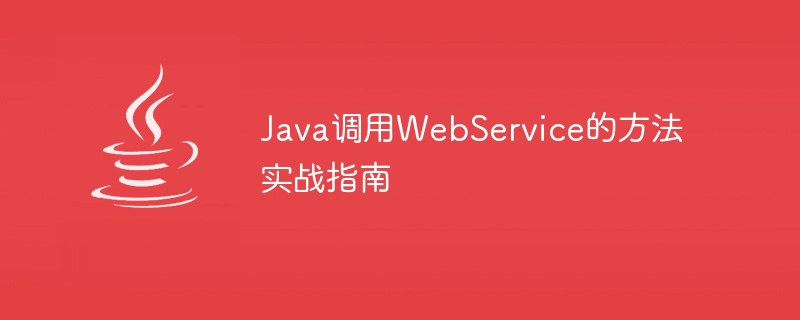

Practical guide on how to call WebService in Java
1. Introduction
With the rapid development of the Internet, Web services have become an important part of modern software development. important parts of. Web services provide a standardized method based on the network so that different applications can communicate with each other, share data, and achieve cross-platform interoperability. In Java development, calling external web services is a very common requirement. This article will take you step by step to understand how to call an external WebService in Java and provide you with specific code examples.
2. Commonly used WebService calling methods
There are many ways to call WebService in Java, such as using the traditional SOAP (Simple Object Access Protocol) or the more concise REST ( Representational State Transfer). In this article, we focus on the method of calling WebService using SOAP protocol.
3. Preparation work
Before starting to call WebService, we need to prepare some necessary work. First, we need to obtain the service description file (WSDL, Web Services Description Language) of WebService. You can obtain this file by entering the address of the WebService in the browser plus the "?wsdl" suffix. Then, we need to generate client code based on the WSDL file to call it in Java. Java provides a command line tool wsimport that can generate client code based on WSDL files. For example, use the following command to generate client code:
wsimport -s <生成代码的目录> <WSDL文件的路径>
The generated code will include the interface and implementation class of WebService, etc.
4. Steps to call WebService
Below, we will introduce step by step how to call WebService in Java.
1. Create a client reference
When calling WebService in Java, we need to create a client reference for accessing WebService. This reference can be created using the interface from the code generated in the previous step. For example, assuming that the interface in the code we generate is named HelloWorldService, you can use the following code to create a reference:
HelloWorldService service = new HelloWorldService();
2. Get the server interface
Next, we need to get it through the client reference Server-side interface. This interface is used to call methods defined in WebService. You can use the following code to obtain the server interface:
HelloWorld helloWorld = service.getHelloWorldPort();
3. Call the WebService method
Now, we can use the server interface to call the method in WebService. Depending on the specific definition of WebService, there may be multiple methods that can be called. For example, suppose our WebService defines a method called sayHello, which accepts a string type parameter and returns a string type result. We can use the following code to call this method:
String result = helloWorld.sayHello("World");After the call is completed, we can get the result of the request and process it accordingly.
5. Code Example
The following is a simple code example that demonstrates how to call a simple WebService in Java.
import com.example.HelloWorld;
import com.example.HelloWorldService;
public class WebServiceClient {
public static void main(String[] args) {
try {
HelloWorldService service = new HelloWorldService();
HelloWorld helloWorld = service.getHelloWorldPort();
String result = helloWorld.sayHello("World");
System.out.println(result);
} catch (Exception e) {
e.printStackTrace();
}
}
}6. Summary
This article introduces how to call WebService in Java and provides specific code examples. Through these steps, you can easily call external WebService to realize data interaction and sharing between applications. I hope this article can help you call WebService in Java development.
The above is the detailed content of A practical guide to implementing WebService calls using Java. For more information, please follow other related articles on the PHP Chinese website!




